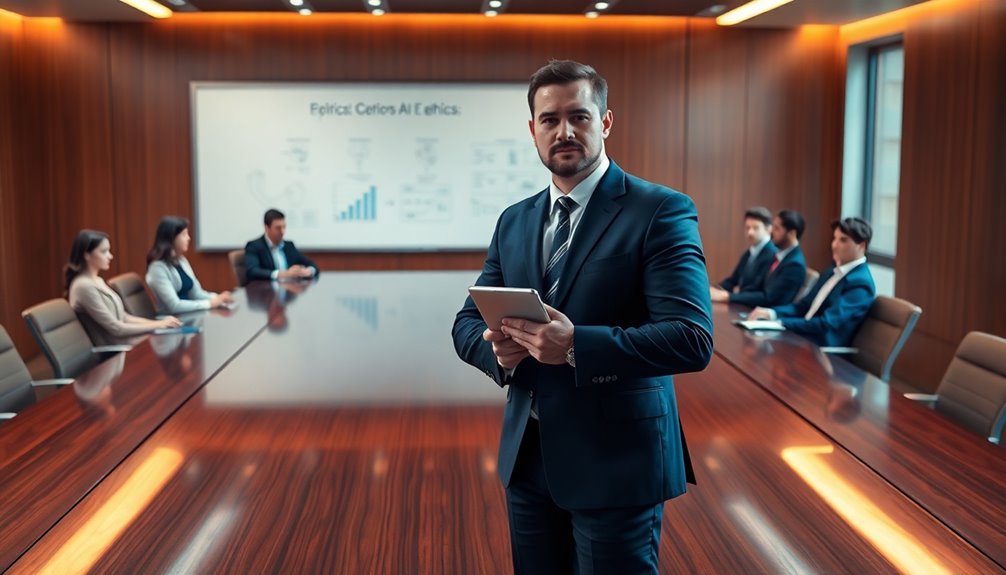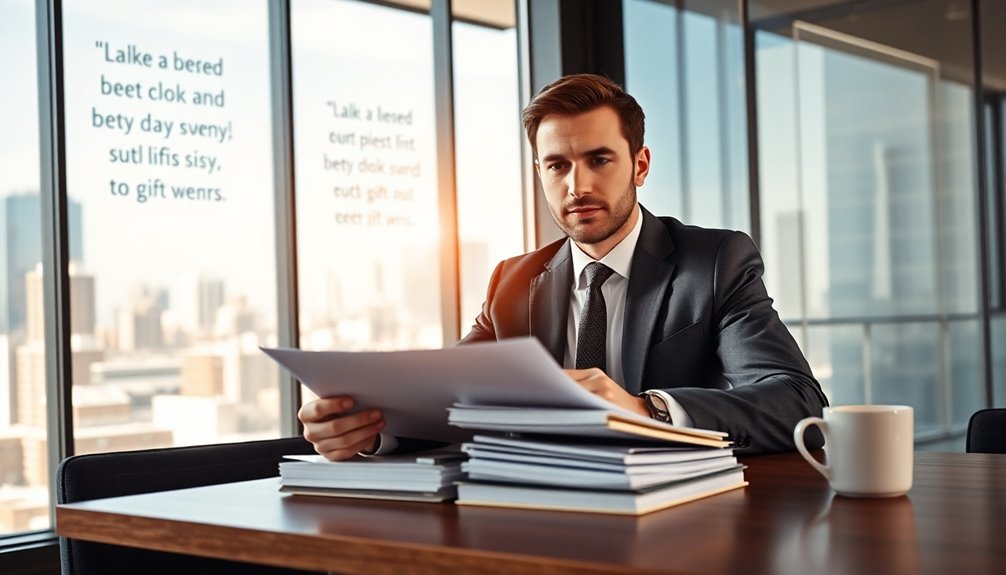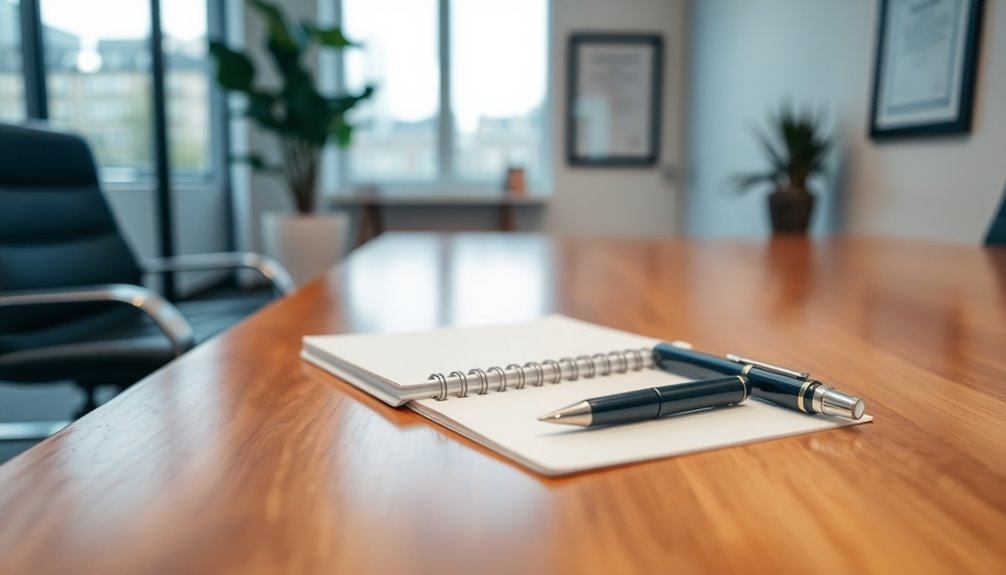To impress in any interview, you've got to dress with professionalism and confidence. For men, a well-fitting suit in navy or gray, paired with a plain dress shirt and conservative tie, sets the right tone. Women should opt for tailored suits with blazers and knee-length skirts or dress pants in similar colors. Closed-toe shoes and understated accessories complete the look. Pay attention to grooming; neat hair and polished shoes make a strong impression. Understanding the company culture helps you choose the perfect outfit. Discover more tips on how to elevate your interview attire to guarantee your success.
Key Takeaways
- Choose well-fitting business formal attire, such as a tailored suit for men and a blazer with dress pants for women, in conservative colors.
- Ensure your shoes are polished and match your outfit; opt for closed-toe shoes for women and dress shoes for men.
- Pay attention to grooming details, keeping hair neat, nails clean, and facial hair trimmed to enhance your professional appearance.
- Research the company culture to select appropriate attire; overdressing is preferable to underdressing if unsure about the dress code.
- Bring multiple copies of your resume and prepare insightful questions to demonstrate your preparedness and interest in the company.
Importance of Interview Attire
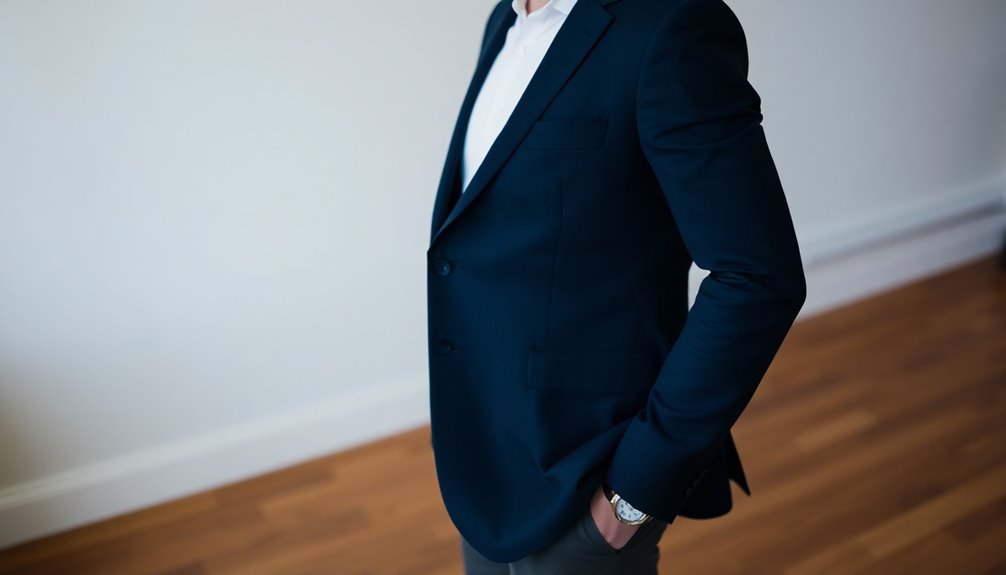
When it comes to job interviews, the right attire can make all the difference. Your choice of clothing demonstrates your seriousness about the job and respect for both the company and the interviewer's time. By dressing professionally, you reflect a commitment to the job search and set a positive tone for the entire interview. It shows you understand workplace norms and standards.
Researching the company culture helps you choose the appropriate attire. Adapting your outfit to fit the company's dress code increases your chances of fitting in and making a good impression. Different industries have varying expectations, so knowing what's acceptable is essential. Dressing to fit company culture enhances relatability and shows that you are a good fit for the team.
Wearing professional attire not only enhances your appearance but also boosts your confidence. Feeling good in what you wear can improve your posture and body language, leading to better performance during the interview. Attention to detail in your outfit signals that you're meticulous and detail-oriented.
Business Formal Attire for Men

Dressing in business formal attire is essential for making a strong impression in job interviews. Start with a well-fitting suit in navy, gray, or black. A single-breasted suit is preferred, and remember to keep the top button buttoned while leaving the bottom button undone. If your jacket has only one button, keep it buttoned for a polished look. Make sure your suit is tailored for a precise fit.
Choose a plain dress shirt, ideally white, with long sleeves. Avoid shirts with colored collars, as they can be distracting. Pair your shirt with a conservative tie that complements your outfit; the tie tip should meet the center of your belt buckle.
Your shoes and belt should match and be polished. Black shoes are a solid choice for formal settings, so make sure they're clean and well-maintained. Your belt should be of high quality and coordinate with your shoes.
Finally, pay attention to grooming. Keep your hairstyle neat and facial hair trimmed. If your shirt has double cuffs, consider wearing cufflinks. Opt for simple tie chains or bars, and use cologne sparingly to maintain a professional demeanor. Additionally, a polished appearance communicates respect for the hiring team's time.
Business Formal Attire for Women
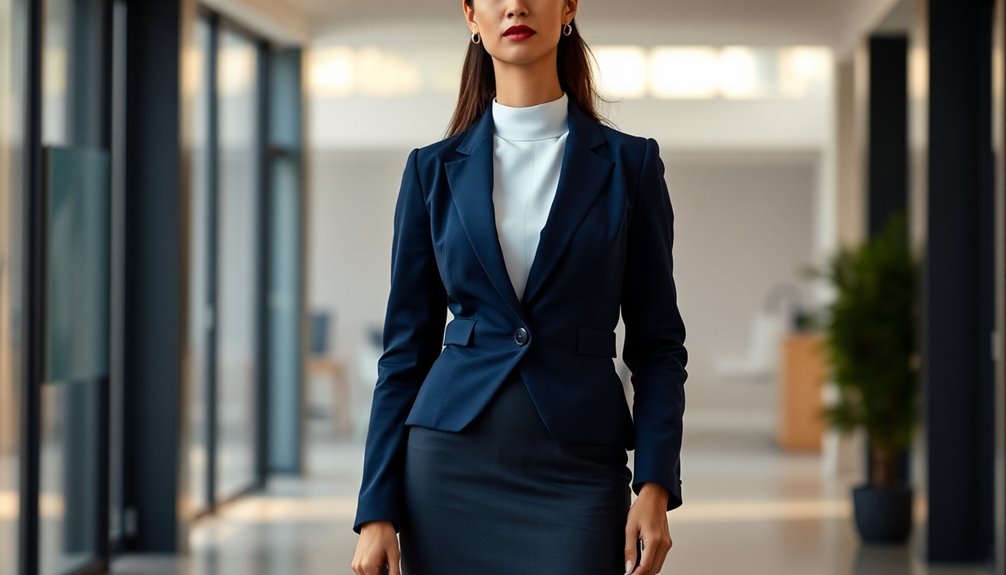
Business formal attire for women is essential for making a lasting impression in interviews. You'll want to choose tailored suits that include blazers paired with dress pants or knee-length skirts. Opt for conservative colors like black, navy, grey, or white to maintain a professional look. When selecting tops, go for long-sleeved blouses or sleeveless options layered with a jacket.
Closed-toe shoes are a must; mid-heeled or flat options work best. Keep your accessories minimal and non-distracting—a simple watch and one statement piece, like a pendant necklace or diamond studs, can elevate your outfit without overpowering it.
Knee-length skirts and formal dresses are both excellent choices, especially when worn with a jacket. Make sure your hemlines are modest and that you wear stockings or pantyhose, even in warmer months. A well-groomed appearance is vital, so pay attention to your hairstyle and makeup. Impeccable grooming is a critical aspect of respect for the professional environment, reinforcing the importance of a complete and polished appearance.
Lastly, remember to adhere to any specific company guidelines and understand the industry norms for business formal attire. Prepare a stylish yet functional handbag to complete your polished look, ensuring you're ready to impress.
Business Casual Options

Steering through the world of interviews doesn't always require a formal dress code; business casual options can be just as effective in making a positive impression. The key is to balance professionalism with comfort. Here are some essential items to reflect on for your business casual wardrobe:
- Button-Down Shirts: Opt for clean, pressed shirts in white or light colors. Tuck them in for a polished look.
- Slacks or Trousers: Choose well-fitting dress slacks in neutral colors like black, blue, or grey. Avoid jeans unless you know they're acceptable. Dress slacks or khakis preferred in business casual settings can enhance your overall appearance.
- Jackets or Blazers: A well-fitted blazer can elevate your outfit. Look for classic designs that add structure while keeping you warm.
- Footwear: Leather shoes are a must. Chukkas or oxfords work well for men, while women can choose closed-toe shoes or ankle boots.
Essential Accessories and Grooming
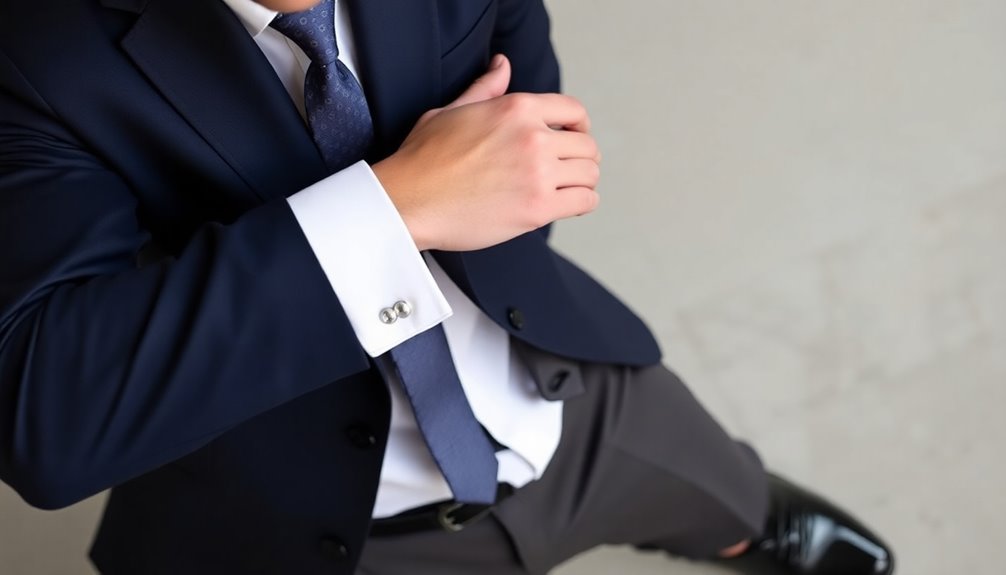
When preparing for an interview, essential accessories and grooming can greatly enhance your overall presentation. Opt for simple and elegant jewelry that complements your outfit without drawing too much attention. Classic stud earrings, a delicate necklace, or a slim bracelet work well; avoid large or flashy pieces that might distract from your conversation. Make certain your jewelry matches the formality of your attire and reflects your personal style while remaining professional. Additionally, it's essential to choose understated jewelry to ensure that your qualifications remain the focal point.
Grooming is equally important. Keep your hair neat and styled appropriately for the occasion. If you have facial hair, guarantee it's trimmed and tidy. Your nails should be clean and well-groomed; if you're unsure about company policies, consider going without polish. Use a light fragrance—nothing overpowering—to maintain a fresh scent.
When it comes to accessories, wear a watch and, if applicable, a wedding ring. Keep other jewelry minimal, opting for just two pieces. A leather portfolio or briefcase adds to your organized look, and polished shoes appropriate for the job sector are a must. Paying attention to these details can make a significant difference in your interview impression.
Adapting to Workplace Culture

Your interview outfit sets the tone, but understanding workplace culture is just as important for making a lasting impression. Before you step into that interview, take a moment to research the company's culture. This knowledge will help you tailor your approach and outfit to fit seamlessly within the organization.
Here are four key aspects to take into account when adapting to workplace culture:
- Core Values: Identify the company's core values and reflect them in your outfit. If they emphasize professionalism, opt for classic styles. If creativity is valued, feel free to add a touch of flair.
- Dress Code: Familiarize yourself with the company's dress code. Is it business formal, casual, or somewhere in between? Aligning your outfit with their expectations shows you're a good fit.
- Team Dynamics: Consider the team's atmosphere. If it's collaborative and relaxed, you might tone down your outfit. If it's competitive, a sharper look could resonate better. Diverse teams yield 19% higher revenue, so demonstrating an understanding of the team culture could positively impact your impression.
- Communication Style: Pay attention to how employees communicate. A more formal style may require a polished appearance, while a laid-back vibe allows for a more casual approach.
Understanding these elements will help you connect effectively during your interview.
General Dress Tips for Interviews
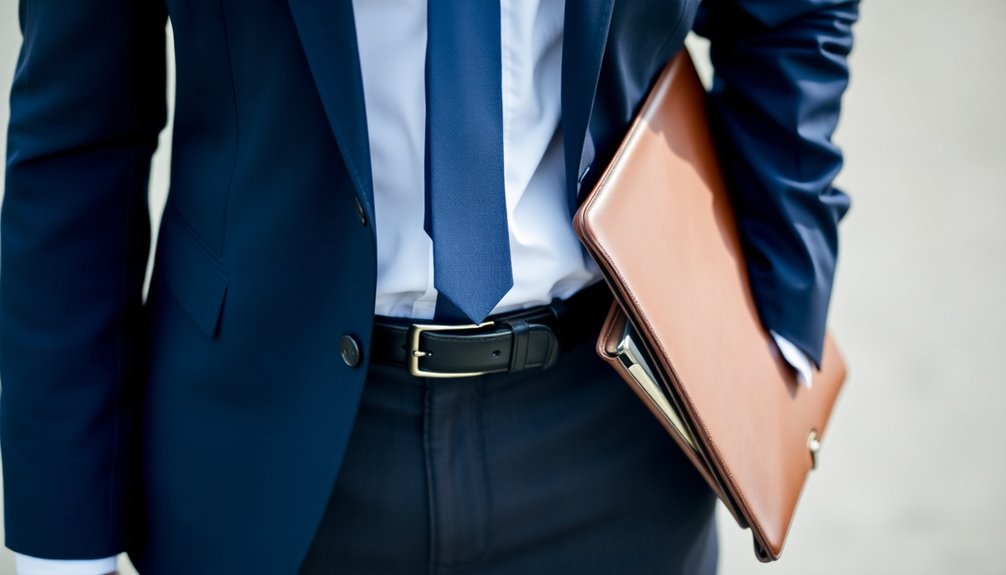
Choosing the right outfit for an interview can greatly impact your first impression, so it's essential to align your attire with the company's expectations. Start by researching the company's dress code through their website or social media. If you're uncertain, it's better to be slightly overdressed than underdressed. For corporate roles, a suit and tie for men or a skirt suit for women are ideal. In business casual settings, opt for a blazer paired with dress pants for men or tailored pants with a blouse for women.
Ensure your clothes fit well—ill-fitting attire can be distracting. Well-fitting clothes enhance appearance and boost confidence, making it crucial to choose outfits that fit you perfectly. Pay attention to grooming; clean shoes, polished accessories, and neat hair make a difference. Stick to minimal jewelry and avoid overly trendy pieces or large logos.
Select breathable fabrics to keep you comfortable during the interview, and consider the weather when choosing your outfit. For instance, avoid sandals in cold weather. Finally, prepare a spare outfit in case of unexpected mishaps. Dressing thoughtfully not only shows respect for the interview process but also boosts your confidence.
Final Preparations Before the Interview

Final preparations before an interview can greatly enhance your chances of success. You want to enter the room feeling confident and well-prepared. Here's what you should focus on:
- Research the Company: Explore the company's history, products, and key stakeholders. Understanding these elements will help you connect during the interview, and demonstrating knowledge of the role can significantly strengthen your position. Additionally, researching the company culture can help you align your responses with company values, showcasing your fit within the organization.
- Physical and Mental Readiness: Prepare healthy meals and get a good night's sleep. Practice breathing techniques to manage any pre-interview anxiety. Engaging in mindfulness exercises can also improve your focus and clarity.
- Interview Materials: Review your notes, resume, and cover letter. Bring multiple copies of your resume, a list of references, and a notepad. Knowing the interviewer's name is also essential.
- Question Preparation: Prepare insightful questions to ask the interviewer about the company culture and growth opportunities. Use the STAR method to articulate your experiences clearly. Demonstrating your problem-solving abilities through specific examples can further impress the interviewer.
Frequently Asked Questions
What Should I Wear if the Interview Is Virtual?
When you're preparing for a virtual interview, you should focus on looking professional from head to toe. Choose a well-fitted button-down shirt or blouse in neutral tones, paired with tailored pants. Avoid distracting prints and opt for simple jewelry. Make sure your background is clean and organized, and remember to wear shoes to boost your confidence. Finally, keep your hairstyle neat for a polished appearance that reflects your professionalism.
Can My Outfit Reflect My Personality?
You might think your outfit doesn't matter, but it really reflects who you are. When you choose clothes that resonate with your personality, you express your individuality and boost your confidence. Whether you lean towards bold colors or prefer a more classic look, your choices can communicate your mood and values. Embrace your style, and let your outfit be a canvas that showcases your unique identity and self-worth.
How Do I Choose the Right Color for My Outfit?
Choosing the right color for your outfit starts with understanding the message you want to convey. Stick to neutral colors like navy blue, gray, or black for professionalism and authority. If you're in a creative field, consider darker shades of green to express originality. Always take your skin tone into account—cool undertones pair well with blues, while warm undertones suit warmer shades. Avoid overly bright colors unless they fit your industry's vibe.
Should I Wear a Watch to the Interview?
Yes, you should wear a watch to the interview, as it can enhance your professional appearance. Choose a simple, classic design that complements your outfit without being distracting. Make sure it's clean and in good condition. Match it with your belt and shoes to maintain a cohesive look. Avoid flashy or noisy watches, as they can draw attention away from the conversation. A well-chosen watch reflects your attention to detail and professionalism.
What if I Feel Uncomfortable in Formal Attire?
If you feel uncomfortable in formal attire, you're not alone. It can be tough to strike a balance between looking professional and feeling at ease. Consider choosing breathable fabrics that fit well, so you don't have to fuss with your clothes. You can dress slightly above the norm without going overly formal. Remember, when you feel good in what you wear, it boosts your confidence, helping you shine during the interview.
Conclusion
In the game of interviews, your outfit is your armor. By choosing the right attire, you not only elevate your confidence but also make a lasting impression. Remember to adapt to the company's culture and add those final touches with accessories and grooming. With everything in place, you'll walk into the interview ready to conquer. So suit up, show up, and let your professionalism shine—you're not just dressing for the job; you're dressing for success.
Emmeline is the backbone of our content creation team, bringing complex psychological concepts to life with clarity and empathy. As our Expert Writer, she crafts engaging, insightful articles that guide readers through the intricacies of personality assessments and what they reveal about the human condition. Her passion for psychology and personal development shines through in every piece she writes.

